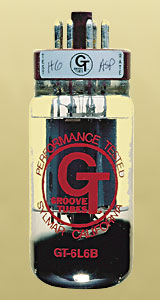Current Shop Hours:
10:00AM to 4:30PM
Tues thru Thur
We can repair your guitar amp, bass amp, tube
amp, solid state amp, P.A. system, mixer,
power amp, guitar wiring, bass wiring, speaker system, effects pedals and
other pro audio equipment. We are an authorized repair center for
many brands. Work is done in our repair shop located in
Sarasota, Florida. Check our used gear for amps, mixers, speakers and
other equipment. We are a Groove Tubes dealer. We do Mercury
Magnetics transformer installs. Check the photo gallery for some photos of
vintage tube amps and other equipment in for
repair.
Thanks for stopping
by!
We are an authorized Groove Tubes dealer

|
About Groove Tubes |
|
|

How We Get That Groove Tubes Sound
Guitarists both yesterday and today can be linked by one piece of equipment: The tube amp. With all the strides in transistor amp technology, guitarists still prefer tube amps. Why do tube amp designs sound and feel differently from solid-state? Simply, tubes work differently.
What is a tube? A tube is an electronic device consisting of a minimum of four active elements: a heater (filament), a cathode, a grid and a plate. All sealed in a vacuum glass enclosure to prevent parts from burning. Once heated, the cathode begins to emit electrons, which flow from the cathode (which is negatively charged) toward the plate (which is positively charged). The grid's purpose is to control this flow, in effect, acting as a valve.
How do Tubes Work? When the guitar's pickup produces a small voltage (the result of the string vibrating in the pickup's magnetic field), this signal is applied to the grid, which causes a large current flow from the cathode to the plate.
Because of this, a correspondingly large voltage now appears at the plate. A portion of the amp's electronic circuitry, the grid bias control, adjusts the proper voltage setting of the grid. When the grid bias is properly set, the tube is balanced to the circuit, and therefore produces a clean, powerful signal. The plate is connected to an output transformer, which matches the impedance to that of the speaker.
How do Tubes Distort? As the signal emitting from the plate approaches its maximum potential, the tube gradually begins to react less and less to the original input signal. This results in a type of compression of the signal, and the signal becomes cut off or "clipped." Tube distortion ("clipping") occurs gradually, producing low order distortion which compliments the original signal, creating a warm sound. This is also why it's easy to move between clean and distorted tones.
| Gary Dahle Pro Audio Repair is an authorized service center for Ampeg, Blackstar, Crate, Crest Audio, EVH, Eden, Fender, Gallien Krueger, Gretsch, Groove Tubes, Hartke, Hughes and Kettner, Kustom, Line6, Mackie, Marshall, Mercury Magnetics, Mesa Boogie, Peavey, Randall, Samson, Sound Tech, SWR, Traynor, Vox and Yorkville products. |
|
Website designed and created by Gary Dahle Pro Audio Repair. Copyright 2010 Gary Dahle Pro Audio Repair. All Rights reserved. |